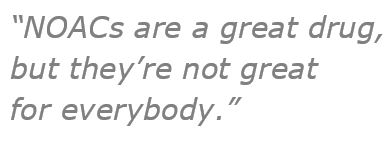
Boston Scientific has announced the final five-year outcomes data from the PREVAIL study during a late-breaking clinical trial session at this year’s Transcatheter Cardiovascular Therapeutics (TCT; 29 October-2 November 2017, Denver, USA. The data, in combination with five-year outcomes from the PROTECT-AF clinical trial, compared the safety and efficacy of the Watchman left atrial appendage closure (LAAC) device to long-term warfarin therapy for patients with non-valvular atrial fibrillation (AF). Principal study investigator Vivek Reddy (Mount Sinai Hospital, New York, USA) spoke to Cardiac Rhythm News about the trial and its outcomes.
In the PREVAIL and PROTECT-AF randomized clinical trials, LAAC with the WATCHMAN device was compared to warfarin for stroke prevention in high-risk patients with non-valvular AF. In addition to stroke prevention comparable to warfarin, the analysis concluded the WATCHMAN device also effectively reduced non-procedure related major bleeding, disabling or fatal stroke, and mortality.
The analysis confirmed a 55% reduction in disabling or fatal stroke, largely driven by an 80% statistically significant reduction in hemorrhagic stroke. Further, the combined data demonstrated a 52% decrease in non-procedure related major bleeding and 27% reduction in all-cause mortality when compared to long-term warfarin therapy.
Speaking to Cardiac Rhythm News, principal study investigator Vivek Reddy (Mount Sinai Hospital, New York, USA) described the study design which enabled the authors to conduct a meta analysis combining all the data from the 1,114 randomized patients for a total of 4,343 patient years upon completion of five year follow up in both PREVAIL and PROTECT-AF.
Two trials, one design
“We previously reviewed the PROTECT-AF data after four years, at which point the PREVAIL had about 18 months of data,” Reddy says. “The initial clinical trial was designed with a statistical plan for PREVAIL that we borrowed from PROTECT-AF, including patient populations and some data. Like PROTECT-AF, it was designed to finish at 18 months and follow up over four to five years.” At the five-year follow-up, Reddy explains, the analysis plan was identical to the one used at 18 months. “Because both trials were based on the same design, with largely the same patient populations and even largely similar investigators, we were able to combine both datasets to do a patient-level meta-analysis.”
Long-term outcomes: no news is good news
“I think they key point is the fact that nothing really has changed”, Reddy says of the final outcomes compared to previously reported trial data, “in the sense that even after 5 years we’re seeing benefits in terms of reduced haemorrhagic stroke and reduced mortality. And I think that’s the important point, that we have the same benefit point after five years.”

The long-term data is an important quality of the combined trials that Reddy stresses as a significant quality of the outcomes. “For a device trial, it is critical that you get long-term follow-ups, and with patients who have had the device for a long period of time. So we were pretty happy to get five-year data.”
“If you look for example at all the novel oral anticoagulant (NOAC) trials, they mainly stopped at around two years. So what we have here is pretty long-term data, obviously they do have far more patients for NOAC trials, but again I think the long-term data is important, and the long-term data from PREVAIL and PROTECT-AF show a similar overall stroke rate, decreased haemorrhagic stroke rates, and decreased mortality. Those are, I think, the two big issues.”
Where NOACs fit into a Watchman vs. warfarin comparison
When asked how recent improvements with NOACs might change LAAC device decisions in clinical applications, Reddy remarks: “The fact is the device was studied against warfarin, but obviously NOACs are better drugs, and we have them now.”
As studies increasingly show, NOACs compare favourably to other oral anticoagulants, with apixaban vs. warfarin being the most distinct improvement in safety and efficacy. What remains understudied, however, is a direct comparison between NOACs and LAAC devices such as Watchman. Although indirectly comparing data seems favourable for appendage closure according to Reddy, he thinks it is going to be some time before more comprehensive data comes out. “At the moment, we don’t have any direct NOAC vs. appendage closure data, so I think that’s an important limitation to how we apply this in clinical process.”
 “But the flipside is that there are lots of patients who don’t tolerate NOACs either. Even in the NOAC clinical trials, there was a quarter, to a third of the patients that had to stop taking the drugs at two years. So NOACs are a great drug, but they’re not great for everybody.”
“But the flipside is that there are lots of patients who don’t tolerate NOACs either. Even in the NOAC clinical trials, there was a quarter, to a third of the patients that had to stop taking the drugs at two years. So NOACs are a great drug, but they’re not great for everybody.”
It is for this group of patients–for whom OACs are contraindicated or otherwise inappropriate–that the LAAC device becomes an important option to consider; one that Reddy says “the data suggests is a very reasonable alternative.” He grants however, “That doesn’t mean that you put it in every one of those patients, and there are other factors that are certainly important, but [patient intolerance to OACs] is a critical one.”
Despite the PREVAIL and PROTECT-AF data showing the Watchman device to be a safe and effective alternative to warfarin, medical therapy may continue to be the first choice of healthcare professionals. Reddy comments, “I think the way most people process their patients is they try to put them on an anti-coagulant, usually a NOAC, and if there’s a problem with it then they usually consider appendage closure. And to me, that makes sense.”












